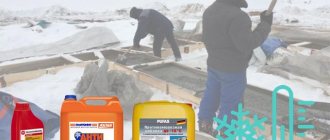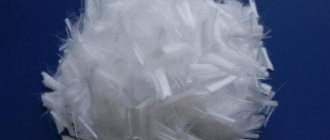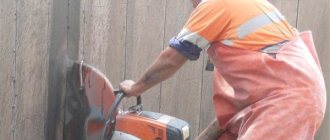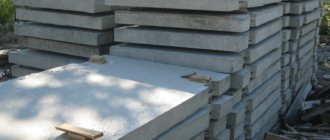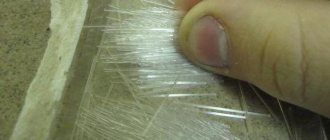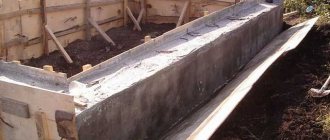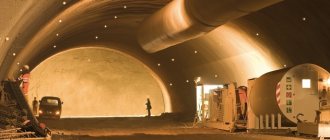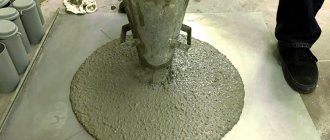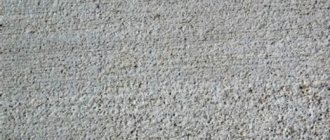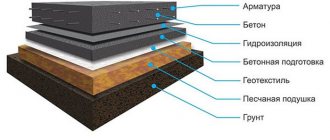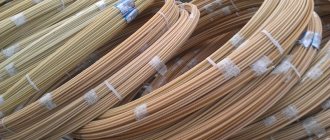Fiber function
Using a classic reinforcing screed is not always convenient, and if it is laid in large areas, the installation process becomes labor-intensive.
Fiber screed is a complete replacement for the iron reinforcing mesh used for mounting the base.
The use of fiber provides the following advantages:
- The additive increases the strength characteristics of concrete, due to which the structure maintains an unchanged structure over a long period of operation.
- This fiber is endowed with increased resistance to significant temperature changes, which means that the finished floor is impervious to cold.
- Reduces the degree of moisture penetration into the screed.
- The addition of this additive shortens the drying time of the screed, and this in turn reduces the period of repair as a whole.
- The additive eliminates possible subsidence and cracks in the concrete base.
The fiber for floor screed is distributed throughout the entire volume of the solution, which cannot be achieved with a classic reinforcing mesh. Due to this, a reinforcement effect is achieved with a smaller thickness of the screed, which plays an important role in rooms where the ceiling height is a critical indicator.
Types of fiberglass for screed
Let's look at what types of fiber fiber there are.
Basalt fiber
One of the available varieties is fiber made from basalt raw materials.
A characteristic distinctive feature of basalt fiber is its excellent resistance to mechanical stress and various types of natural influences. An additive of this type prevents destruction of the base. Even if through cracks occur, the rest of the floor will remain intact.
This additive is recommended for use in areas with increased seismic activity, as well as in climatic zones with significant temperature changes and aggressively humid climates.
Basalt fiber fiber
Polypropylene fiber
Polypropylene fiber differs from the above in that it is used to make so-called lightweight concrete and to make plaster.
The period of trouble-free use of polypropylene fiber is slightly shorter than that of basalt fiber. Otherwise, it performs the same functions of plasticizing and fastening the screed.
Polypropylene fiber has become very widespread due to its affordable price; the only drawback of this product is the presence of counterfeits, and a low-quality additive significantly reduces the service life of the screed and leads to its rapid destruction.
To perform quality work, you must purchase only high-quality and certified products with certificates of conformity. If the product does not have all the necessary documents, then it is better to refuse to purchase such a product.
The most optimal consumption of polypropylene fiber
The most optimal composition of fiber-reinforced concrete is in which the consumption of polypropylene fiber is 1.0-1.4 kg/m3, while the compressive strength increases to 30%, and the tensile strength during bending by 15-20%. Exceeding the consumption rate of PP fiber by more than 2 kg/m3 leads to its clumping, a decrease in compressive strength, and also to an unjustified increase in the price of fiber-reinforced concrete.
-concrete/reinforced concrete fiber consumption 0.7-1.0 kg/m3 of finished concrete
- self-leveling floors, floor screed fiber consumption 1.2-1.5 kg/m3
-dry building mixtures fiber consumption – 1.0 kg/m3.
- plaster fiber consumption 0.9-1.2 kg/m3.
- for paving slabs and stone, fiber consumption is 1.2-1.5 kg/m3.
- for small architectural forms, fiber consumption is 1.5-2.0 kg/m3.
- for a flat roof, fiber consumption is 1.3-1.5 kg/m3.
Fiber for concrete can be mixed in any way in mixers and concrete mixers of forced and gravity type, including machine-mounted mixers. It mixes well and does not form lumps thanks to the lubricating composition applied to its surface.
How to calculate fiber
There is no strict dosage as such; the amount of supplement used varies depending on the desired result:
- If you only need the effect of improving the binding properties and to make it easier to work with the solution itself, then add 300 grams per 1 m3 of solution.
- To achieve the reinforcement effect, you need to add 600 g/m3.
- And in order to get a screed with the best properties of polypropylene and concrete stone, you need to add at least 800 grams of fiber per cubic meter of solution.
If you need to calculate the additive consumption per 1 m2, then you must perform the following steps:
We determine how thick the screed needs to be. For example, you need to pour 5 cm of solution.
Next we perform the following calculation:
where 1000 is the value of 1 meter written in millimeters, 50 is the height of the future screed in millimeters, 20 is the number of times it is necessary to reduce the amount of additive used, then we calculate the required fiber per square meter:
800 / 20 = 40 g/m2.
To obtain the amount of fiber required for the entire area of the room, you simply need to multiply the total area of the room by the result obtained above.
Adding fiber to the solution
Preparation of solution with fiber
- Preparing the base. The surface must not have defects or damage, and must also be primed and dried.
- The zero level is determined using a laser or water level and marked on the walls.
- Next, the beacon system is installed.
- Preparation of the solution. To better distribute the fiber in the mixture, first mix the dry ingredients and then add the required amount of water.
- Next, the prepared solution is placed on the surface and leveled according to the installed beacons using the rule. Next, after the floor has partially dried, it is necessary to remove the beacons and seal the resulting niches with mortar.
Then you need to wait time for the screed to fully mature, during this period to exclude the presence of drafts in the room.
Why is floor screed with fiberglass performed?
The need to strengthen the concrete composition with fiber fibers is related to its properties. The hardened concrete mass has an increased safety margin. It is able to withstand compressive loads and, at the same time, loses its integrity under the influence of tensile forces and bending moments. During operation, a cement screed that does not have reinforcement gradually collapses.
Cement floor screed
A floor screed with fiber fiber evenly distributed inside the mass allows you to:
- increase the strength characteristics of the base;
- reduce shrinkage of building materials;
- increase service life;
- increase the plasticity of the floor base;
- reduce the time it takes for the mixture to harden;
- ensure resistance to temperature fluctuations;
- prevent cracking and delamination;
- evenly distribute the load on the concrete base.
The use of fiber filler improves the performance properties of the screed. Fiber fiber for floor screed has serious advantages and is used when performing repair work.
Features of polypropylene fiber VSM-12
Polypropylene fiber is round synthetic fibers 12 mm in length and 12 microns in diameter. The surface of each fiber fiber is coated with a special composition, which allows the fiber to be evenly distributed in the cement mass and adhere to the concrete mixture.
Areas of use of polypropylene fiber
- Production of all types of cement mortars and concretes, foam concrete, aerated concrete and other products made of cement or gypsum;
- Screeding of industrial and domestic floors;
- Production of fiber-reinforced concrete resistant to high seismic activity;
- Reinforcement of concrete structures, bridges, hydraulic structures;
- Production of paving slabs, interior and exterior decoration of buildings;
- Concreting of open areas, parking lots.
Polypropylene fiber VSM-12 mm allows you to:
- reduce delamination of the cement mixture by up to 20%;
- increase frost resistance by up to 30% and increase the flexural and compressive strength of the solution;
- reduce the tension inside the solution during shrinkage by up to 55% and reduce the hardening time;
- increase the wear resistance of cement floors by up to 65%;
- Reduce the risk of shrinkage cracks by up to 90%.
The amazing properties of fiber include the fact that polypropylene fiber is resistant to acids and chemical additives in solution, does not deform when preparing the solution, and is not susceptible to corrosion processes.
Fiber fiber for screed - types, characteristics, properties
Depending on the components used for manufacturing, fiber screeds are classified as follows:
- metal. The steel filler is characterized by increased resistance to temperature changes and an increased safety margin. This allows it to be used in industrial premises, where the strength and durability of concrete are negatively affected by increased loads, vibration and surface abrasion. Steel fibers are susceptible to high humidity and also have increased weight compared to fiber counterparts made from other materials;
- basalt. The reinforcing material has a set of advantages - increased resistance to open fire and temperature, resistance to corrosion processes, high humidity, and high impact strength. A filler made of basalt threads ensures the integrity of the concrete base even when through cracks occur. These advantages make it possible to use the material for pouring floors in buildings erected in seismically active zones, as well as in rooms with increased moisture concentration;
- polypropylene. Synthetic fibers made of polypropylene have reduced weight and are characterized by resistance to aggressive substances. The reinforcing material is dielectric, which allows it to be safely used both for screeding a heated floor base and as a standard leveling coating. The reasonable price of fiber filler allows it to be used in private construction to solve a wide range of problems - from floor screed to plastering walls.
Polypropylene fiber fiber
In addition to the above varieties, the following materials are used for the manufacture of fiber reinforcement:
- fiberglass. It is used for facade cladding of buildings and the manufacture of concrete products of complex configuration;
- asbestos thread. The operational properties of the building material allow it to be used only for finishing the facade walls of buildings.
Among the fillers used to strengthen screeds, polypropylene threads are widely used, which fully replace steel filler and basalt fibers. Let's look at the characteristics:
- length is 6000–18000 µm;
- cross-sectional size is 10–20 µm;
- ability to withstand tensile loads of 1700–2600 kg/cm2;
- specific gravity does not exceed 900 g/cm2;
- the temperature threshold for ignition exceeds 300 degrees Celsius;
- the elongation coefficient at break is 1.5–2.5.
The properties of the material added to cement or concrete mortar make it possible to increase their resistance to aggressive liquids.
Baumex polymer fiber Baumix steel fiber Polypropylene fiber Baucon | FIBERS FOR REINFORCEMENT Concrete reinforced with steel and polypropylene fibers is a material belonging to the group of composites, i.e. so-called fiber-reinforced concrete. Compared to conventional concrete, fiber-reinforced concrete is characterized by increased resistance to cracks and scratches , impact resistance, resistance to crushing and stretching. The effectiveness of fibers in concrete depends primarily on the characteristics and content of the fibers, their shapes and sizes, and their adhesion to the hardened cement mortar. Taking these parameters into account, as well as experience in the field of flooring, Bautech, with the participation of leading research centers in Poland, invented and patented its own type of steel fibers BAUMIX and polypropylene - BAUCON. |
Polymer fiber Recommended
BAUMEX® is an innovative, patented synthetic fiber made from a new, durable, highly resistant polymer material. Serving as the main frame of a structure, the product replaces traditional mesh reinforcement and steel reinforcing fibers, strengthening the structure of concrete. The unique shape and unique characteristics of the synthetic material provide effective penetration into the structure and excellent placement of fibers in concrete.
Catalog Technical map
Steel fiber
Thanks to the use of relatively short and thin Baumix steel fibers, fiber- reinforced concrete becomes more uniform than traditionally reinforced concrete, thanks to the hook-shaped ends of the fibers, which can easily enter the cement matrix. The effectiveness of Baumix steel fibers is evidenced by their flexibility, i.e. ratio of fiber length to diameter. The greater the flexibility of the fiber, the higher its efficiency, and as a result, less fiber is required.
d - diameter, l - length, λ - flexibility
in favor of using steel fibers as an alternative to traditional reinforcement, in particular: the possibility of significantly reducing the floor slab , eliminating material costs for reinforcement, its components and installation work, and transportation costs.
Baumix steel fiber reinforced concrete is a homogeneous concrete with uniformly distributed reinforcement, which affects:
- increased tensile strength when bending (within flexible deformation)
- increased resistance to damage
- reduction in deformation from 20 to 40%
- increased compression resistance
- increased abrasion resistance
- increased resistance to dynamic loads
- increase in frost resistance
- increased corrosion resistance
- increased resistance to technical fatigue
- high resistance to sudden temperature fluctuations
Technical map
Polypropylene fiber
BAUCON polypropylene fibers primarily serve as reinforcement, preventing deformation of the material. Their operating time is limited to the moment when the concrete itself begins to tolerate a higher tensile stress than the stress carried by polypropylene fibers. The innovative form of Baucon polypropylene fibers allows you to obtain optimal mixture parameters from 600 g/m3 of concrete.
Polypropylene fibers
Adding polypropylene fibers to concrete affects:
- effective resistance to cracks and breaks during the first period of concrete bonding
- steel mesh elimination
- reduction of moisture capacity and water permeability
- increase in frost resistance
- improving the cohesion and homogeneity of concrete
- improved corrosion resistance
- improved abrasion resistance
Technical map
| Polymer fibers | ||
| BAUMEX® polymer microfibers for concrete reinforcement A patented synthetic fiber made from a new, durable polymer material with high resistance. Serving as the main frame of a structure, the product replaces traditional mesh reinforcement and steel reinforcing fibers, strengthening the structure of concrete. Fiber consumption from 1.5 kg/m3 of concrete. read more | ||
| Steel reinforcing fibers | ||
| 60 | Steel reinforcing fibers Baumix® 60 for effective distributed reinforcement of industrial floors and road surfaces. More effective than traditional mesh reinforcement; increases the strength characteristics of concrete. read more | |
| 50 | Steel reinforcing fibers Baumix® 50 for effective distributed reinforcement of industrial floors and road surfaces. More effective than traditional mesh reinforcement; increases the strength characteristics of concrete. read more | |
| Polypropylene reinforcing fibers | ||
| Baucon® polypropylene reinforcement fibers, which eliminate shrinkage phenomena, thereby increasing the strength characteristics of concrete and its water resistance. Material consumption is 0.6 kg/m3 of concrete. read more | ||
see also
News
Stock
Comparison of systems
Call export!
Which floor, for which buildings
Tags: polymer fibers, fiber, steel fibers, polypropylene fiber, for concrete reinforcement
How to make screed with fiber fiber - technology of work
The sequence of actions for planning the floor surface using concrete mortar with the addition of fiber fiber corresponds to the algorithm for constructing a traditional screed. The set of measures includes the following stages:
- Finishing the surface to the required conditions.
- Determining the level of the poured solution.
- Preparation of a mixture with fiber fiber.
- Pouring the mixture and leveling it.
Let us dwell in detail on the specifics of performing individual stages of work.
Preparing the surface
Preparation of the base surface involves performing the following work:
- Removing existing floor covering.
- Cleaning the surface from construction debris.
- Visual inspection of the base for defects.
- Cutting detected cracks.
- Cleaning the edges of the prepared cavities.
- Abundantly moisten the surface with water.
- Sealing with cement-sand mortar.
- Clean up dust using a vacuum cleaner.
- Gluing damping tape along the contour of the walls.
We produce semi-dry screed with fiber fiber
A semi-dry screed with fiber reinforcement allows you to form a reliable and even concrete base for finishing in a limited time. The technology provides:
- minimal hydration of the composition;
- reinforced with plastic fiber.
You can use a stand mixer to mix the dry ingredients evenly. Sequencing:
- Prepare the base.
- Complete the markup.
- Lay thermal insulation.
- Install and secure beacons.
- Prepare a sand-cement mixture in a 3:1 ratio.
- Add 0.6 kg/m 3 fiber and mix.
- Add a little water until semi-dry.
- Lay the solution in a layer of 3–5 cm and level it.
After drying, sand the surface and cut expansion joints. Lay the finishing coating a week after pouring.
Features of the use of polypropylene fiber fiber
Experts recommend pouring fiber for floor screed into the dry mixture, mixed in a mixer, before adding water. To ensure maximum distribution of fiber fiber in the solution, it must be added in small portions.
The level of its operational parameters directly depends on the amount of fiber fiber introduced into the screed. Adding only 300 g of fiber to 1 cubic meter of concrete mixture will greatly facilitate the process of laying it. And already 600 g can significantly increase the strength characteristics of semi-dry floor screed.
Fiber fiber is traditionally made from polypropylene threads having a length of 18, 12 or 6 mm. The optimal option for arranging a leveling layer using semi-dry technology is fiber with fibers of 12 mm.
It is also necessary to take into account that to lay 1 m2 of a leveling layer 50 mm thick, to give it fairly good performance characteristics, it is enough to add 40-45 g of fiber fiber to the mixture. In monetary terms, it will cost only 8-9 rubles.
In addition, the addition of fiber will make it possible to prevent the occurrence of certain technological problems that inevitably arise during the use of fine mesh metal wire in semi-dry screeds.
Some subtleties of laying fiber fiber in screeds
Despite the fact that fiber for floor screed allows you to simplify the procedure for laying the leveling layer, it is advisable to know some of its features before starting.
It is advisable to start the process with careful preparation of the base. It is necessary to make it dry, clean and as smooth as possible. In addition, the entire base surface must be treated with a deeply penetrating primer. This will make it possible to increase its adhesion.
Using various types of levels and beacons, set the thickness of the leveling layer. Prepare the solution. At the same time, we remember that fiber is added in small portions to the dry mixture with thorough mixing. And only then it is diluted with water. Using a pneumatic blower, the solution is applied in a layer no thicker than 3-5 cm. To level the semi-dry screed, we use a roller.

